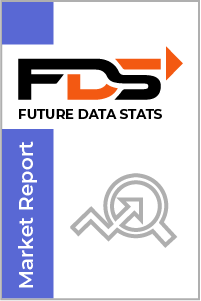The global Smart City Cloud Infrastructure Market size was valued at USD 150 Billion in 2024 and is projected to expand at a compound annual growth rate (CAGR) of 16% during the forecast period, reaching a value of USD 500 Billion by 2032.
The "Smart City Cloud Infrastructure Market Research Report" by Future Data Stats provides an in-depth examination of the market landscape, utilizing historical data from 2021 to 2023 to identify key trends and growth patterns. Setting 2024 as the foundational year, the report explores consumer behavior, competitive forces, and regulatory frameworks that influence the industry. It transcends basic analysis, delivering a thoroughly researched forecast extending from 2025 to 2033. By employing sophisticated data analysis methodologies, the report not only outlines the market's growth trajectory but also uncovers emerging opportunities and foresees potential obstacles, empowering stakeholders with vital insights to adeptly navigate the changing market landscape.
MARKET OVERVIEW:
The Smart City Cloud Infrastructure Market refers to the deployment and use of cloud computing solutions to support the development and management of smart cities. These solutions enable cities to enhance operational efficiency, improve public services, and ensure sustainability through the integration of technologies like IoT, big data analytics, and AI. Cloud infrastructure in smart cities helps optimize resources such as energy, transportation, water management, and security, enabling more responsive and efficient urban management. For the market's purpose, the Smart City Cloud Infrastructure Market encompasses the various cloud-based systems, services, and applications that municipalities, governments, and enterprises adopt to create connected and intelligent urban environments. The growing adoption of cloud technologies allows for scalable and flexible solutions, helping cities reduce operational costs while improving the quality of life for their residents. As urbanization continues, the demand for such infrastructure is expected to increase, driving further growth in this market.
MARKET DYNAMICS:
The latest trends in the Smart City Cloud Infrastructure Market highlight a strong shift toward the integration of advanced technologies like artificial intelligence, machine learning, and the Internet of Things (IoT). Cities are increasingly leveraging cloud-based platforms to manage vast amounts of real-time data generated by sensors and connected devices. This shift is driven by the need for smarter traffic management, energy optimization, and improved public safety. Furthermore, the focus on sustainability is pushing the adoption of green cloud solutions, which help reduce carbon footprints and manage resources more efficiently. Looking ahead, the Smart City Cloud Infrastructure Market is expected to experience significant growth as more cities implement 5G networks and edge computing. These technologies will enable faster data processing and real-time decision-making, which are essential for the next generation of smart city applications. Additionally, businesses can tap into the expanding scope of this market by offering tailored cloud solutions, providing cloud management services, and developing platforms that support emerging smart city needs such as digital twin technology and autonomous vehicle integration. As cities continue to digitize, the business opportunities in this market will grow across various sectors, including urban planning, energy management, healthcare, and public transportation.
Cities are leveraging cloud technology to enhance service delivery, optimize resource allocation, and improve connectivity. This shift enables local governments to implement data-driven policies, leading to better public safety, traffic management, and environmental sustainability. As urban populations swell, the need for scalable infrastructure that can support various smart applications becomes imperative, pushing municipalities to adopt cloud solutions. However, challenges such as data privacy concerns and high implementation costs can hinder market expansion. Many stakeholders are apprehensive about sharing sensitive information on cloud platforms, which can slow down adoption rates. Despite these restraints, significant opportunities exist for companies specializing in innovative cloud services. By addressing security and cost challenges, these firms can create tailored solutions that meet the unique needs of urban areas. As cities strive for technological advancement, the potential for growth in the smart city cloud infrastructure market remains substantial.
SMART CITY CLOUD INFRASTRUCTURE MARKET SEGMENTATION ANALYSIS
BY TYPE:
The Smart City Cloud Infrastructure Market is classified into three main types: public cloud, private cloud, and hybrid cloud. Public cloud services are widely adopted due to their cost-effectiveness, scalability, and ease of access. They allow municipalities and companies to share resources over the internet, eliminating the need for heavy investments in physical infrastructure. In contrast, private cloud offers more control and security, appealing to governments and enterprises that need to keep sensitive data protected while taking advantage of cloud computing benefits.
Hybrid cloud solutions combine the best of both worlds, enabling smart cities to optimize their infrastructure by keeping critical data in a private cloud while leveraging the public cloud for less sensitive information and scalable resources. This flexibility ensures that smart city projects meet various needs, from resource optimization to security compliance, making cloud infrastructure a critical component in the development of connected urban spaces.
BY COMPONENT:
The components of Smart City Cloud Infrastructure include hardware, software, and services, each playing a vital role in supporting the digital transformation of cities. Hardware components such as servers, storage devices, and network equipment provide the foundational infrastructure necessary for cloud deployment. Servers handle data processing and storage, while storage devices ensure efficient data management, and network equipment enables seamless data transmission across systems. Software components, like cloud management and security software, are essential for optimizing cloud operations and ensuring data security, enabling city administrators to control infrastructure efficiently and safeguard sensitive information.
Furthermore, services such as consulting, integration, deployment, and ongoing support are crucial in implementing and maintaining smart city systems. These services ensure that cities can transition smoothly to cloud-based infrastructures and sustain them with high-performance standards, guaranteeing long-term success in smart city initiatives.
BY DEPLOYMENT MODEL:
The deployment models in the Smart City Cloud Infrastructure Market include on-premises and cloud-based systems, each offering unique benefits. On-premises deployment refers to the installation and management of cloud infrastructure within a city's own premises, providing full control over security, data privacy, and system management. This model is typically favored by government agencies or utilities that require strict control over sensitive data and mission-critical systems. On the other hand, cloud-based deployment relies on remote cloud service providers to host infrastructure and data management.
This model is cost-effective and scalable, providing cities with the flexibility to expand their operations without needing to invest heavily in physical infrastructure. Cloud-based solutions also offer real-time updates, remote monitoring, and easy integration with emerging technologies like IoT, which are essential for the efficient operation of smart cities. Both deployment models are integral to the growth and modernization of urban spaces, with cities choosing between them based on their specific needs for control, scalability, and cost management.
BY APPLICATION:
Smart City Cloud Infrastructure serves a range of applications, transforming urban living through improved resource management and enhanced services. Smart transportation systems leverage cloud infrastructure to enable real-time traffic management, improve public transportation systems, and reduce congestion, making urban mobility more efficient and sustainable. Similarly, the smart grid application uses cloud technologies to optimize energy distribution, reduce waste, and integrate renewable energy sources. In healthcare, cloud solutions allow for the management of electronic health records, telemedicine services, and real-time patient monitoring, enhancing healthcare delivery and accessibility. Educational institutions also benefit from cloud technologies, offering online learning platforms and digital classrooms that are more flexible and accessible.
Other critical applications like smart water management and smart security help optimize resource use and enhance safety, respectively, by providing real-time monitoring and automated responses to incidents. These applications demonstrate the versatility of cloud infrastructure in transforming cities into more efficient, connected, and sustainable environments.
BY END-USER:
The end-users of Smart City Cloud Infrastructure include governments, enterprises, utilities, healthcare providers, and educational institutions, all of which utilize cloud technologies to enhance urban living. Governments are the primary drivers of smart city initiatives, leveraging cloud infrastructure to improve public services, enhance citizen engagement, and optimize urban planning. Enterprises, both large and small, use cloud-based solutions to streamline their operations, increase productivity, and enable the use of data analytics to inform decision-making. Utilities are increasingly adopting cloud solutions to manage energy, water, and waste systems, ensuring greater efficiency and sustainability in resource management.
Healthcare providers rely on cloud infrastructure for managing patient data, providing telemedicine services, and improving healthcare accessibility. Educational institutions benefit from cloud technologies by offering online learning platforms, digital classrooms, and administrative tools that improve educational experiences. Each of these end-users plays a critical role in shaping the future of smart cities, and their adoption of cloud infrastructure is central to achieving the goals of smarter, more sustainable urban environments.
REGIONAL ANALYSIS:
In North America, the Smart City Cloud Infrastructure Market is driven by strong government initiatives, technological advancements, and widespread adoption of IoT solutions. The region benefits from robust infrastructure, including high-speed internet and data centers, which supports the deployment of smart city solutions. Cities like New York, San Francisco, and Toronto are increasingly adopting cloud technologies to improve public services, energy management, and urban mobility. Additionally, private sector involvement and investments from major cloud service providers are accelerating market growth, positioning North America as a leader in smart city development.
Europe is also witnessing significant advancements in the Smart City Cloud Infrastructure Market, with a focus on sustainability and innovation. European governments are prioritizing the development of smart cities to meet environmental goals and improve urban efficiency. Cities such as Amsterdam, Barcelona, and Berlin are incorporating cloud solutions to manage public transportation, smart grids, and waste management systems. In addition, European Union regulations promoting green technologies and data protection are shaping the market, encouraging the adoption of cloud services while ensuring compliance with stringent laws. The increasing demand for eco-friendly and energy-efficient infrastructure positions Europe as a key region for the expansion of smart city cloud solutions.
MERGERS & ACQUISITIONS:
- In Jan 2024: Microsoft acquired IoT platform provider Airship to enhance its smart city cloud capabilities.
- In Feb 2024: Cisco partnered with Siemens to integrate cloud infrastructure for urban digital twin solutions.
- In Mar 2024: IBM acquired Turbonomic to boost AI-driven cloud automation for smart city applications.
- In Apr 2024: Amazon Web Services (AWS) launched a new Smart City Data Hub for real-time urban analytics.
- In May 2024: Oracle merged with C3.ai to strengthen AI-powered cloud solutions for smart governance.
- In Jun 2024: Google Cloud expanded its partnership with Sidewalk Labs for scalable urban cloud infrastructure.
- In Jul 2024: Huawei acquired Hexagon’s smart city division to enhance its cloud-based urban management systems.
- In Aug 2024: SAP partnered with Bosch to integrate IoT and cloud platforms for smart city mobility.
- In Sep 2024: Salesforce launched a new Smart City Cloud Suite for citizen engagement platforms.
- In Oct 2024: AT&T acquired IoT startup Actility to bolster its smart city connectivity solutions.
- In Nov 2024: Schneider Electric merged with AVEVA to expand cloud-based smart city energy management.
- In Dec 2024: NVIDIA partnered with Dell Technologies to deploy AI-driven cloud infrastructure for urban planning.
KEY MARKET PLAYERS:
- Microsoft
- Amazon Web Services (AWS)
- Google Cloud
- IBM
- Oracle
- Cisco
- Siemens
- Huawei
- SAP
- Bosch
- Schneider Electric
- NVIDIA
- Dell Technologies
- Hitachi
- Ericsson
- AT&T
- Verizon
- GE Digital
- Honeywell
- Accenture
Smart City Cloud Infrastructure Market: Table of Contents
Introduction
- Overview
- Market Definition
- Scope of the Study
Market Dynamics
- Drivers
- Restraints
- Opportunities
- Challenges
Market Segmentation
- By Type
- By Component
- By Deployment Model
- By Application
- By End-User
Competitive Landscape
- Market Share Analysis
- Key Strategies
- Company Profiles
Regional Analysis
- North America
- Europe
- Asia Pacific
- Latin America
- Middle East & Africa
Market Trends & Developments
- Technological Innovations
- Emerging Market Trends
Conclusion
- Key Findings
- Market Outlook
Smart City Cloud Infrastructure Market Segmentation
By Type:
- Public Cloud
- Private Cloud
- Hybrid Cloud
By Component:
- Hardware
- Servers
- Storage Devices
- Network Equipment
- Software
- Cloud Management Software
- Security Software
- Services
- Consulting
- Integration and Deployment
- Support and Maintenance
By Deployment Model:
- On-Premises
- Cloud-based
By Application:
- Smart Transportation
- Smart Grid
- Smart Healthcare
- Smart Education
- Smart Water Management
- Smart Security
By End-User:
- Government
- Enterprises
- Utilities
- Healthcare Providers
- Educational Institutions
By Geography:
- North America (USA, Canada, Mexico)
- Europe (UK, Germany, France, Italy, Spain, Rest of Europe)
- Asia-Pacific (China, Japan, Australia, South Korea, India, Rest of Asia-Pacific)
- South America (Brazil, Argentina, Rest of South America)
- Middle East and Africa (GCC Countries, South Africa, Rest of MEA)
WHY SHOULD YOU INVEST IN A MARKET RESEARCH REPORT?
Smarter Business Decisions:
A high-quality market research report delivers valuable insights into industry trends, customer preferences, and competitor strategies. With solid data guiding your choices, you can minimize risks and confidently pursue new opportunities—whether launching a product or expanding into new markets.
Spot Hidden Opportunities:
Market research uncovers unmet customer needs and emerging trends before they become mainstream. By aligning your products or services with these opportunities, you can stay ahead of the competition and capture untapped demand.
Know Your Competition Inside Out:
Gain a clear picture of your competitors' strengths, weaknesses, and strategies. This knowledge helps you refine your unique selling points, craft stronger positioning, and outmaneuver rivals effectively.
Sharper, More Effective Marketing:
Understanding your audience is key to successful marketing. Market research reveals who your customers are, what drives their decisions, and how they engage with brands. With these insights, you can create tailored campaigns that deliver better results and higher ROI.
Reduce Risks Before They Arise:
Every business move carries some risk—but research helps you anticipate challenges before they become costly. By analyzing market conditions and potential obstacles, you can make proactive adjustments to protect your bottom line and reputation.
Strengthen Your Case for Funding:
Investors and lenders want proof of market potential before backing a business. A well-researched report provides the data-driven evidence they need, boosting your credibility and increasing your chances of securing capital.
Stay Ahead of Industry Shifts:
Markets evolve fast, with new technologies, regulations, and consumer behaviors constantly reshaping the landscape. Regular market research ensures you stay informed, adapt quickly, and maintain a competitive edge in your industry.
RESEARCH METHODOLOGY AT FUTURE DATA STATS
At Future Data Stats, we combine decades of industry expertise with cutting-edge research techniques to deliver unparalleled market intelligence. Our team of seasoned analysts employs a dynamic, data-driven approach to uncover actionable insights, helping businesses navigate complex market landscapes with confidence.
Comprehensive & Cutting-Edge Market Analysis
We go beyond surface-level trends to provide a 360-degree view of market dynamics. Our research methodology is designed to:
✔ Accurately assess market size, growth patterns, and competitive landscapes.
✔ Identify emerging opportunities through real-time trend analysis and predictive modeling.
✔ Validate findings with high-quality data, expert consultations, and independent verification.
Our insights empower decision-makers with strategic clarity, ensuring they stay ahead in rapidly evolving industries.
Multi-Source Data Collection & Validation
We leverage a diverse mix of primary and secondary research sources, including:
- In-depth stakeholder interviews (industry leaders, suppliers, distributors, and end-users)
- Statistical databases & market reports from authoritative global sources
- Regional market intelligence to capture localized trends and demand shifts
- Proprietary analytical models tailored to specific industry needs
- By cross-verifying data from multiple streams, we ensure maximum accuracy and reliability.
Key Advantages of Our Research Approach
- Actionable Intelligence – Clear, data-backed recommendations for strategic planning.
- Technology-Enhanced Accuracy – Advanced tools for data validation and trend forecasting.
- Unbiased Insights – Independent analysis free from external influence.
Our Two-Tier Research Framework
- Primary Research – Direct Industry Engagement
- Expert Interviews: Over 25+ hours of discussions with key stakeholders across the value chain.
- Targeted Surveys: Structured questionnaires for KOLs (Key Opinion Leaders) to gauge market sentiment.
- Competitive Benchmarking: Assessing leading players to determine market positioning.
- Secondary Research – Extensive Data Synthesis
- Analysis of 3,000+ documents, including industry reports, whitepapers, and regulatory publications.
- Global & regional data mining from government databases, trade journals, and financial reports.
- Macroeconomic & sector-specific trend mapping for long-term forecasting.
Dual Analytical Approach
We employ both top-down and bottom-up methodologies to ensure precision:
- Bottom-Up Analysis: Calculating market size from granular data, ensuring detailed accuracy.
- Top-Down Assessment: Validating findings through macroeconomic indicators and industry benchmarks.
Why Choose Future Data Stats?
✔ 70+ years of collective expertise in market intelligence.
✔ Customized research models for sector-specific accuracy.
✔ Transparent, reliable, and forward-thinking insights.
With Future Data Stats, you don’t just get data—you get a strategic advantage. Partner with us to unlock the full potential of your market decisions.
Smart City Cloud Infrastructure Market Dynamic Factors
Drivers:
- Rapid urbanization increasing demand for smart city solutions.
- Growing adoption of IoT and connected devices driving cloud infrastructure needs.
- Increased government investments in smart city projects.
- Need for efficient management of urban resources and services.
- Enhanced data security and scalability offered by cloud platforms.
Restraints:
- High initial infrastructure setup costs.
- Data privacy and security concerns.
- Integration challenges with legacy systems.
- Lack of skilled workforce to manage cloud systems.
- Regulatory complexities in managing data across borders.
Opportunities:
- Expansion of 5G networks enhancing cloud adoption.
- Growing demand for AI and big data analytics in smart cities.
- Strategic partnerships between cloud providers and governments.
- Rise in demand for green and sustainable cloud solutions.
- Increased focus on improving citizen engagement through cloud-enabled platforms.
Challenges:
- Managing large volumes of real-time data generated by smart city applications.
- Ensuring seamless interconnectivity among diverse city systems.
- Balancing cost efficiency with advanced cloud infrastructure requirements.
- Addressing concerns over the digital divide in developing regions.
- Overcoming resistance to cloud adoption from traditional city management systems.
Smart City Cloud Infrastructure Market Regional Key Trends Analysis
North America:
- Growing smart city initiatives supported by federal and local governments.
- Expansion of cloud services due to 5G rollouts.
- Increasing adoption of AI and analytics for traffic management.
Europe:
- High focus on sustainability and green cloud infrastructure.
- Collaborative efforts between governments and private sector for smart city solutions.
- Rising investments in smart mobility and connected transportation systems.
Asia Pacific:
- Rapid urbanization boosting smart city infrastructure demand.
- Government support for digital transformation in urban planning.
- Increasing use of IoT technologies for smarter city management.
Latin America:
- Government-driven smart city projects enhancing urban development.
- Growing mobile connectivity leading to more cloud-based solutions.
- Rising demand for innovative energy management systems in cities.
Middle East & Africa:
- Investment in smart city infrastructure as part of national development plans.
- Growing interest in cloud-based solutions for security and surveillance.
- Increased focus on water and waste management technologies.
Frequently Asked Questions

















